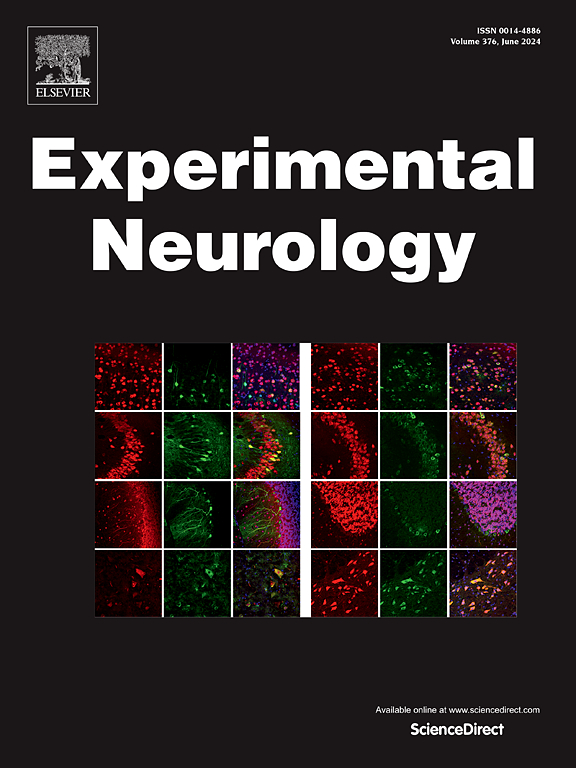Age differences in organophosphorus nerve agent-induced seizure, blood brain barrier integrity, and neurodegeneration in midazolam-treated rats
IF 4.6
2区 医学
Q1 NEUROSCIENCES
引用次数: 0
Abstract
Exposure to organophosphorus nerve agents irreversibly inhibits acetylcholinesterase and may lead to cholinergic crisis and seizures. Although benzodiazepines are the standard of care after nerve agent-induced status epilepticus, when treatment is delayed for up to 30 min or more, refractory status epilepticus can develop. Adult male rodents are often utilized for evaluation of therapeutic efficacy against nerve agent exposure. However, there may be age and sex differences in toxicity and in therapeutic response. We previously reported that juvenile rats are less susceptible to the lethal effects of soman compared to adults, while pups are the most susceptible. Here, we report on age and sex differences in delayed midazolam treatment efficacy on survival, seizures and brain pathology. Male and female pups, juvenile and adult rats were exposed to an equitoxic dose of soman and treated with atropine sulfate and the oxime asoxime chloride (HI-6 dimethanesulphonate) 1 min after exposure and with midazolam 40 min after seizure onset, determined by EEG in juvenile and adult rats, and by behavior in pups. Survival, seizure data, and spontaneous recurrent seizures were evaluated. Brains were processed to assess neurodegeneration, neuroinflammation, and blood brain barrier (BBB) integrity. Juvenile and adult rats exposed to soman and treated with midazolam had BBB disruption, epileptogenesis, neurodegeneration, microglial activation, and astrogliosis; adult rats had poorer outcomes. Pups and juvenile rats exposed to soman had poor survival prior to midazolam treatment but most survived once treated; overall, neurodegeneration or disrupted BBB integrity was not detected in midazolam-treated pups. We found that age is a determinant factor in soman-induced toxicity and response to standard medical countermeasures. In addition, we observed sex differences in response to soman in juveniles and males with respect to body weight growth curves and in neuronal loss in juveniles and adults. Adjunct therapies to midazolam are warranted and it is important to evaluate both age and sex as factors in therapeutic response.
在咪达唑仑治疗的大鼠中,有机磷神经毒剂引起的癫痫发作、血脑屏障完整性和神经变性的年龄差异。
暴露于有机磷神经毒剂不可逆地抑制乙酰胆碱酯酶,并可能导致胆碱能危象和癫痫发作。虽然苯二氮卓类药物是神经毒剂引起的癫痫持续状态后的标准治疗,但当治疗延迟30 分钟或更长时间时,可能会出现难治性癫痫持续状态。成年雄性啮齿动物经常被用来评估对神经毒剂暴露的治疗效果。然而,在毒性和治疗反应方面可能存在年龄和性别差异。我们之前报道过,与成年鼠相比,幼鼠不太容易受到索曼的致命影响,而幼鼠最容易受到影响。在这里,我们报告了延迟咪达唑仑治疗在生存、癫痫发作和脑部病理方面的年龄和性别差异。将雄性和雌性幼鼠、幼年和成年大鼠暴露于等量剂量的索曼,暴露后1 min给予硫酸阿托品和氯化亚肟肟(HI-6二甲基磺酸)治疗,癫痫发作后40 min给予咪达唑仑治疗,幼年和成年大鼠脑电图测定,幼鼠行为测定。评估生存、癫痫发作数据和自发性复发癫痫发作。对大脑进行处理以评估神经变性、神经炎症和血脑屏障(BBB)的完整性。暴露于索曼并给予咪达唑仑治疗的幼年和成年大鼠出现血脑屏障破坏、癫痫发生、神经退行性变、小胶质细胞激活和星形胶质增生;成年大鼠的结果较差。暴露于索曼的幼鼠和幼鼠在咪达唑仑治疗前存活率较差,但大多数在治疗后存活;总体而言,在咪达唑仑治疗的幼犬中未检测到神经变性或血脑屏障完整性破坏。我们发现年龄是soman诱导的毒性和对标准医疗对策反应的决定因素。此外,我们还观察到幼鱼和雄鱼在体重增长曲线和幼鱼和成年鱼的神经元损失方面对人类的反应存在性别差异。辅助治疗咪达唑仑是必要的,重要的是评估年龄和性别作为治疗反应的因素。
本文章由计算机程序翻译,如有差异,请以英文原文为准。
求助全文
约1分钟内获得全文
求助全文
来源期刊

Experimental Neurology
医学-神经科学
CiteScore
10.10
自引率
3.80%
发文量
258
审稿时长
42 days
期刊介绍:
Experimental Neurology, a Journal of Neuroscience Research, publishes original research in neuroscience with a particular emphasis on novel findings in neural development, regeneration, plasticity and transplantation. The journal has focused on research concerning basic mechanisms underlying neurological disorders.
 求助内容:
求助内容: 应助结果提醒方式:
应助结果提醒方式:


